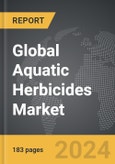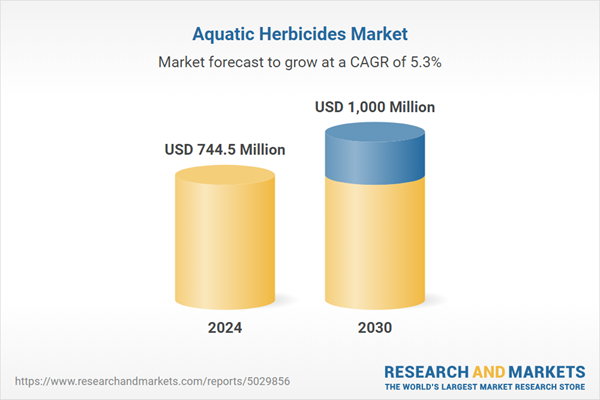The global market for Aquatic Herbicides was valued at US$744.5 Million in 2024 and is projected to reach US$1.0 Billion by 2030, growing at a CAGR of 5.3% from 2024 to 2030. This comprehensive report provides an in-depth analysis of market trends, drivers, and forecasts, helping you make informed business decisions. The report includes the most recent global tariff developments and how they impact the Aquatic Herbicides market.
Segments: Type (Glyphosate, 2,4-D, Imazapyr, Diquat, Triclopyr, Other Types); Action (Non-Selective, Selective); Application Method (Foliar, Submerged); End-Use (Agricultural Waters, Fisheries, Recreational Waters, Other End-Uses).
Geographic Regions/Countries: World; United States; Canada; Japan; China; Europe (France; Germany; Italy; United Kingdom; Spain; Russia; and Rest of Europe); Asia-Pacific (Australia; India; South Korea; and Rest of Asia-Pacific); Latin America (Argentina; Brazil; Mexico; and Rest of Latin America); Middle East (Iran; Israel; Saudi Arabia; United Arab Emirates; and Rest of Middle East); and Africa.
The analysts continuously track trade developments worldwide, drawing insights from leading global economists and over 200 industry and policy institutions, including think tanks, trade organizations, and national economic advisory bodies. This intelligence is integrated into forecasting models to provide timely, data-driven analysis of emerging risks and opportunities.
Global Aquatic Herbicides Market - Key Trends and Drivers Summarized
Why Are Aquatic Herbicides Crucial in Managing Water Ecosystems?
Aquatic herbicides play an essential role in maintaining the health and balance of water ecosystems by controlling the growth of invasive aquatic plants and algae. These plants, if left unchecked, can overtake water bodies, leading to significant ecological disruption, including the loss of native plant species, decreased oxygen levels, and impaired water quality. The uncontrolled spread of invasive species like hydrilla, water hyacinth, and Eurasian watermilfoil has led to serious challenges in lakes, rivers, reservoirs, and irrigation canals worldwide. Aquatic herbicides are specifically formulated to target and manage these invasive species without harming non-target plants and aquatic life. The strategic application of these herbicides ensures that water bodies remain navigable for recreational activities, agricultural use, and drinking water supplies, while also supporting biodiversity by preventing the domination of invasive species. As such, aquatic herbicides are a critical tool in the broader effort to preserve and restore healthy water ecosystems.How Are Technological Advancements Enhancing the Effectiveness of Aquatic Herbicides?
The effectiveness of aquatic herbicides has been significantly enhanced by recent technological advancements in formulation and application methods. One of the most notable developments is the creation of selective herbicides that can target specific invasive species without affecting native plants or aquatic animals. These formulations often include ingredients that are less toxic and more environmentally friendly, addressing growing concerns over the impact of chemicals on water quality and ecosystem health. Moreover, advancements in delivery systems, such as drone technology and precision application tools, allow for more accurate and efficient distribution of herbicides, minimizing the amount needed and reducing the risk of over-application. These technologies not only improve the efficacy of herbicides but also align with increasing regulatory requirements for environmental protection. Additionally, ongoing research into biodegradable herbicides is paving the way for products that break down more quickly in the environment, further reducing their ecological footprint. These innovations are crucial as they help balance the need for effective weed control with the growing emphasis on sustainability in aquatic management practices.What Emerging Trends Are Shaping the Future of Aquatic Herbicides?
Several emerging trends are influencing the future of the aquatic herbicides market, driven by the intersection of environmental concerns, regulatory changes, and technological progress. The rising global awareness of the ecological impact of invasive species is leading to increased investment in integrated weed management strategies that combine chemical, mechanical, and biological controls. This holistic approach is becoming more common as stakeholders seek to minimize chemical use while maximizing the effectiveness of invasive species control. Additionally, the trend towards more sustainable and eco-friendly products is pushing manufacturers to develop herbicides that are not only effective but also meet stricter environmental standards. This includes the use of bio-based ingredients and formulations designed to be less persistent in the environment. The adoption of precision agriculture techniques in aquatic environments is another significant trend, as it allows for targeted application of herbicides, reducing waste and environmental impact. These trends reflect a broader shift towards sustainable water management practices that prioritize both ecological health and effective weed control.What Factors Are Driving Growth in the Aquatic Herbicides Market?
The growth in the aquatic herbicides market is driven by several factors that are closely aligned with the evolving needs of water management and environmental protection. Firstly, the increasing prevalence of invasive aquatic weeds, exacerbated by climate change and global trade, is spurring demand for effective herbicide solutions. As these invasive species spread, they create significant challenges for water quality, navigation, and biodiversity, driving the need for targeted herbicide applications. Secondly, advancements in herbicide technology, including the development of selective and biodegradable formulations, are expanding the market by offering solutions that meet both regulatory requirements and environmental concerns. Thirdly, the rise of integrated water management strategies, which combine chemical, mechanical, and biological controls, is boosting the adoption of aquatic herbicides as a key component of these programs. Additionally, growing public awareness and concern over the impact of invasive species on water bodies are prompting increased government funding and private sector investment in herbicide research and development. These factors, combined with the expanding scope of recreational water activities and the need for clean, navigable water bodies, are driving the robust growth of the aquatic herbicides market.Report Scope
The report analyzes the Aquatic Herbicides market, presented in terms of units. The analysis covers the key segments and geographic regions outlined below.Segments: Type (Glyphosate, 2,4-D, Imazapyr, Diquat, Triclopyr, Other Types); Action (Non-Selective, Selective); Application Method (Foliar, Submerged); End-Use (Agricultural Waters, Fisheries, Recreational Waters, Other End-Uses).
Geographic Regions/Countries: World; United States; Canada; Japan; China; Europe (France; Germany; Italy; United Kingdom; Spain; Russia; and Rest of Europe); Asia-Pacific (Australia; India; South Korea; and Rest of Asia-Pacific); Latin America (Argentina; Brazil; Mexico; and Rest of Latin America); Middle East (Iran; Israel; Saudi Arabia; United Arab Emirates; and Rest of Middle East); and Africa.
Key Insights:
- Market Growth: Understand the significant growth trajectory of the Glyphosate segment, which is expected to reach US$318.0 Million by 2030 with a CAGR of a 5.9%. The 2,4-D segment is also set to grow at 5.8% CAGR over the analysis period.
- Regional Analysis: Gain insights into the U.S. market, valued at $195.0 Million in 2024, and China, forecasted to grow at an impressive 8.0% CAGR to reach $228.0 Million by 2030. Discover growth trends in other key regions, including Japan, Canada, Germany, and the Asia-Pacific.
Why You Should Buy This Report:
- Detailed Market Analysis: Access a thorough analysis of the Global Aquatic Herbicides Market, covering all major geographic regions and market segments.
- Competitive Insights: Get an overview of the competitive landscape, including the market presence of major players across different geographies.
- Future Trends and Drivers: Understand the key trends and drivers shaping the future of the Global Aquatic Herbicides Market.
- Actionable Insights: Benefit from actionable insights that can help you identify new revenue opportunities and make strategic business decisions.
Key Questions Answered:
- How is the Global Aquatic Herbicides Market expected to evolve by 2030?
- What are the main drivers and restraints affecting the market?
- Which market segments will grow the most over the forecast period?
- How will market shares for different regions and segments change by 2030?
- Who are the leading players in the market, and what are their prospects?
Report Features:
- Comprehensive Market Data: Independent analysis of annual sales and market forecasts in US$ Million from 2024 to 2030.
- In-Depth Regional Analysis: Detailed insights into key markets, including the U.S., China, Japan, Canada, Europe, Asia-Pacific, Latin America, Middle East, and Africa.
- Company Profiles: Coverage of players such as Albaugh LLC, BASF SE, Dow, Inc., DuPont de Nemours, Inc., Land O'Lakes, Inc. and more.
- Complimentary Updates: Receive free report updates for one year to keep you informed of the latest market developments.
Some of the 23 companies featured in this Aquatic Herbicides market report include:
- Albaugh LLC
- BASF SE
- Dow, Inc.
- DuPont de Nemours, Inc.
- Land O'Lakes, Inc.
- Lonza Group AG
- Monsanto Company
- Nufarm Limited
- Platform Specialty Products Corporation
- Sanco Industries Ltd.
- Sepro Corporation
- Syngenta AG
- UPL Ltd.
- Valent BioSciences Corporation
Tariff Impact Analysis: Key Insights for 2025
Global tariff negotiations across 180+ countries are reshaping supply chains, costs, and competitiveness. This report reflects the latest developments as of April 2025 and incorporates forward-looking insights into the market outlook.The analysts continuously track trade developments worldwide, drawing insights from leading global economists and over 200 industry and policy institutions, including think tanks, trade organizations, and national economic advisory bodies. This intelligence is integrated into forecasting models to provide timely, data-driven analysis of emerging risks and opportunities.
What’s Included in This Edition:
- Tariff-adjusted market forecasts by region and segment
- Analysis of cost and supply chain implications by sourcing and trade exposure
- Strategic insights into geographic shifts
Buyers receive a free July 2025 update with:
- Finalized tariff impacts and new trade agreement effects
- Updated projections reflecting global sourcing and cost shifts
- Expanded country-specific coverage across the industry
Table of Contents
I. METHODOLOGYII. EXECUTIVE SUMMARY2. FOCUS ON SELECT PLAYERSIII. MARKET ANALYSISCANADAITALYSPAINRUSSIAREST OF EUROPESOUTH KOREAREST OF ASIA-PACIFICARGENTINABRAZILMEXICOREST OF LATIN AMERICAIRANISRAELSAUDI ARABIAUNITED ARAB EMIRATESREST OF MIDDLE EASTIV. COMPETITION
1. MARKET OVERVIEW
3. MARKET TRENDS & DRIVERS
4. GLOBAL MARKET PERSPECTIVE
UNITED STATES
JAPAN
CHINA
EUROPE
FRANCE
GERMANY
UNITED KINGDOM
ASIA-PACIFIC
AUSTRALIA
INDIA
LATIN AMERICA
MIDDLE EAST
AFRICA
Companies Mentioned (Partial List)
A selection of companies mentioned in this report includes, but is not limited to:
- Albaugh LLC
- BASF SE
- Dow, Inc.
- DuPont de Nemours, Inc.
- Land O'Lakes, Inc.
- Lonza Group AG
- Monsanto Company
- Nufarm Limited
- Platform Specialty Products Corporation
- Sanco Industries Ltd.
- Sepro Corporation
- Syngenta AG
- UPL Ltd.
- Valent BioSciences Corporation
Table Information
| Report Attribute | Details |
|---|---|
| No. of Pages | 183 |
| Published | April 2025 |
| Forecast Period | 2024 - 2030 |
| Estimated Market Value ( USD | $ 744.5 Million |
| Forecasted Market Value ( USD | $ 1000 Million |
| Compound Annual Growth Rate | 5.3% |
| Regions Covered | Global |









